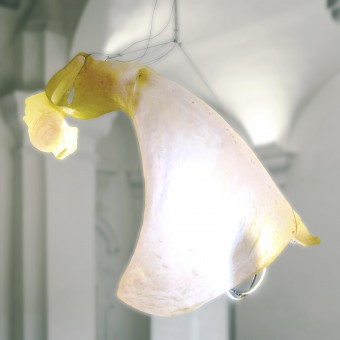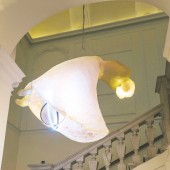
| THE AWARD |
| CATEGORIES |
| REGISTRATION |
| SUBMIT YOUR WORK |
| ENTRY INSTRUCTIONS |
| TERMS & CONDITIONS |
| PUBLICATIONS |
| DATES & FEES |
| METHODOLOGY |
| CONTACT |
| WINNERS |
| PRESS ROOM |
| GET INVOLVED |
| DESIGN PRIZE |
| DESIGN STORE |
| THE AWARD | JURY | CATEGORIES | REGISTRATION | PRESS | WINNERS | PUBLICATIONS | ENTRY INSTRUCTIONS |
Isadora Artistic Lighting by Stefania Vola |
Home > Winners > Design #27419 >Interview |
 |
|
FS: What is the main principle, idea and inspiration behind your design?
SV: This light sculpture named ‘Isadora’ belongs to the series 'Luminaria', sculptures realized in resins of diverse chromatic hues and saturation that embody the human figure draped as anthropomorphic shapes in changing postures. These sculptures become lamps, a poetic object of art design brought into being from an original clay model. In particular ‘Isadora’ evokes the artistic freedom and the poetics of amazing dancer Isadora Duncan (1877-1927), a dancer in the US, considered one of the most important precursors of the so-called ‘modern dance’. This light sculpture is born as a suspension. However, in realizing I saw it was possible to make a floor version, just as interesting and more suited to environments that do not have the height or the appropriate features for the suspended version.
FS: What has been your main focus in designing this work? Especially what did you want to achieve?
SV: When making 'Isadora' I wanted to give shape to the idea of the all-female passion, which certainly has characterized the life and work of Duncan: synthesis of artistic intensity and radical expression, which results in an act of great lightness, almost painful in its freedom. Isadora is finally bright, in its extreme beauty.
FS: What are your future plans for this award winning design?
SV: The prototype of 'Isadora' was realized as part of the collection 'interioritratti' (www.interioritratti.com), the brand I created to start my projects artistically inspired. Unlike other items in the collection, entrusted to specific companies, I want to produce personally 'Isadora' and in general the sculptures of the series 'Luminaria', in limited edition.
FS: Why did you design this particular concept? Was this design commissioned or did you decide to pursuit an inspiration?
SV: The series ‘Luminaria’ for me is extremely important because it allowed me finally to get close to one of my greatest passions, sculpture. I followed my inspiration , I wanted to see this cloth of resin shaped like a dancer, light and bright hovering in the air.
FS: Who is the target customer for his design?
SV: The sculptures of the series 'Luminaria' are directed to a circuit of art galleries - and then to an audience of collectors - and are suitable for particular places, public and private. As I really like the cross-cutting approaches it’s really possible there will be interdisciplinary installations. In addition to 'Isadora' has been realized a subject called 'Blue Green Soul' (a floor lamp), a figure absorbed in a regenerating meditation. Also in the pipeline is the project of a third sculpture (a suspension), choral and quite challenging.
FS: How did you come up with the name for this design? What does it mean?
SV: As I said before my ‘Isadora’ is a tribute to Isadora Duncan (1877- 1927), considered one of the most important precursors of the ‘modern dance’. Born in California Isadora Duncan first moved to London then to Paris, beginning a long series of performances on the European continent, where she won the admiration of many artists and intellectuals. She was the creator of a radical break with the ballet: abolished the pointed shoes and contrived costumes worn by the dancers of the nineteenth century, preferring to wear simple and light, reminiscent of the ancient peplos Greece, and dancing barefoot. Her free dance interpretations were emotional, impressionistic, compositions of famous musicians like Chopin, Ludwig van Beethoven, Christoph Willibald Gluck. She became quite popular for her distinct style and inspired many visual artists, such as Antoine Bourdelle, Auguste Rodin, and Abraham Walkowitz, to create works based on her. She founded, along her troubled life, three schools to teach young women her dance philosophy: in Grunewald (Germany), in Paris and then in Moscow, leaving great influences that garnered Duncan the title of the creator of modern dance. Her focus on natural movement emphasized steps, such as skipping, outside of codified ballet technique. Also, she believed movement originated from the solar plexus, which she thought was the source of all movement. The plastic pose of this sculpture emphasizes the generative force of the solar plexus. In completing the resin model before making the matrix, I saw that the figure was more plastic armless, best expressed the intensity of Isadora ... so that the final version was born.
FS: What is the most unique aspect of your design?
SV: These works involve a return to the figurative: the latest full and characteristic expression has taken place in the Art Deco period, after which the figurative reference was banned by Rationalism. The biggest challenge in my opinion is interpreting these figures - which are presented as objects of art design and then with, in addition to artistic inspiration, an architectural function - without falling into kitsch. For this I have chosen the way of the 'unfinished', so in my intention figure is mentioned and almost suggested by a cloth of resin, lightweight. The details are hazy, fleeting, unimportant ... important is the figure that is evoked, and the emotion associated with it… the rest can and should be completed by the imagination of everyone. The choice of resin as material, brings this interpretation of the sculpture in a contemporary dimension. But the resin, which usually in the design world is sanded and finished to perfection, in this case is deliberately processed in a crude, materic, artistic way.
FS: Who did you collaborate with for this design? Did you work with people with technical / specialized skills?
SV: To achieve these objects of art design is necessary a long processing, for which I first charged a team of young sculptors coordinated by maestro Raffaele Mondazzi, which has a chair at the Accademia Albertina in Turin. In particular, Isadora was followed by Massimo Apicella, who played with great talent my sketches and my intentions. We started by studying the sketches in clay, through the plaster model, until the resin matrix. The processings in resin were carried out by the Cesare Luparia, which in Italy performs various works by Gaetano Pesce. Each piece printed by the matrix is painted by hand, so it’s unique.
FS: What is the role of technology in this particular design?
SV: I wished that these sculptures had a type of contemporaneous lighting, in this case some tapes LED, mounted on a series of circles in Corten steel, that in a playful composition are suspended inside the sculpture and can be glimpsed well in the suspended version. For aspects of illumination of this as of other objects of the series 'interioritratti' I worked in partnership with the TGE (www.tge.it), company expert in electrical installations of large dimensions, which in this case is adept on prototypes.
FS: Thank you for providing us with this opportunity to interview you.
A' Design Award and Competitions grants rights to press members and bloggers to use parts of this interview. This interview is provided as it is; DesignPRWire and A' Design Award and Competitions cannot be held responsible for the answers given by participating designers.
| SOCIAL |
| + Add to Likes / Favorites | Send to My Email | Comment | View Press-Release |





